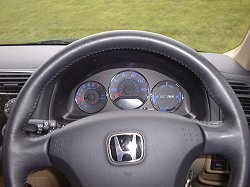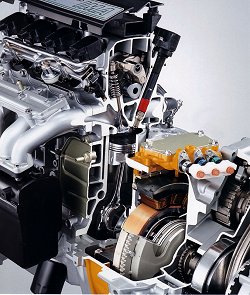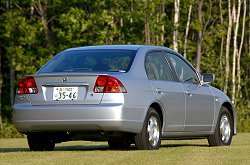

Honda were first on the UK market with a production hybrid car with the Insight, but with only two seats and its futuristic styling, it was never going to be more than a toe-in-the-water exercise to see if there was a market for hybrid vehicles.
Two years after the launch of the Insight and with 220 units sold, Honda has announced their second-generation hybrid car, the Civic IMA (Integrated Motor Assist). This time, the advanced technology is wrapped in a conservative four-door saloon; from the outside there is no clue to what lies underneath.
The IMA system combines a 1.3-litre 90 bhp petrol engine with a thin, lightweight 10 kW electric motor/generator positioned between the engine and the gearbox, that assists the engine when accelerating to boost performance, and recharges under braking to benefit economy. Energy captured during the deceleration cycle is stored in a slim, lightweight MiMH battery back situated in the back of the rear seats, leaving a large conventionally sized boot for luggage.
Honda have chosen to offer the IMA technology in one car only for the time being, the four door Civic in SE Executive trim. This body type is available in the UK with the IMA powerplant option only, and has been priced at the same £13,995 (including £1000 Powershift grant) price as the identically specified Civic SE Executive 5 door. The motive is obvious - the technology should cost no more than a normal petrol engine and the car should be as normal as any other in the range. This is the first application of hybrid technology on an established mainstream platform (indeed over 15,000 units have already been sold in Japan and the USA).
As I approached the Civic IMA nothing stood out - it is a cleanly shaped four door saloon, a market that some manufacturers have forgotten in favour of 5 door hatchbacks, or produce in such small numbers that you rarely see them in the UK. Inside, again the car looks normal - leather upholstery is fitted as standard, but with its heavily perforated pattern it doesn't look as up-market as that in the Accord Executive models.
The instrument panel is the same as other Civics except for the gauge on the right of the binnacle which, as well as providing engine temperature and fuel level functionality, also shows whether the electric motor is charging or discharging. To the left of the binnacle are an annoying pair of arrow lights indicating whether you should change up or down - the change up arrow lit up at about 2,000 rpm, I never did see the change down light come on.
Driving the car also did nothing to betray the technology. Unlike the Toyota Prius, the Civic IMA does not have a silent running 'milk-float' mode around town. The engine is always running unless the car is stationary, even then it will continue to run if the standard fit manual air-conditioning is on. The car pulls away as normal from the cut out mode, the engine having restarted but the driver is totally oblivious to anything having even happened.
The bottom line is that the Civic IMA drives just like any other Civic, if it wasn't for the extra multi-function gauge showing charge/discharge rate an unsuspecting driver would never know there was anything different about this car. And that's how it should be if hybrid technology is going to catch on with the masses. The Car Enthusiast hopes to conduct a more thorough road test later in the year to assess the real day-to-day benefit of the IMA system.
For more information:
Honda UK: www.honda.co.uk
First drive review: 2003 Honda Civic IMA
Story by Trevor Nicosia
Trevor Nicosia currently races Lancias in Britain. Find out more at his site - www.nyssaracing.com.
|

|
|




|



